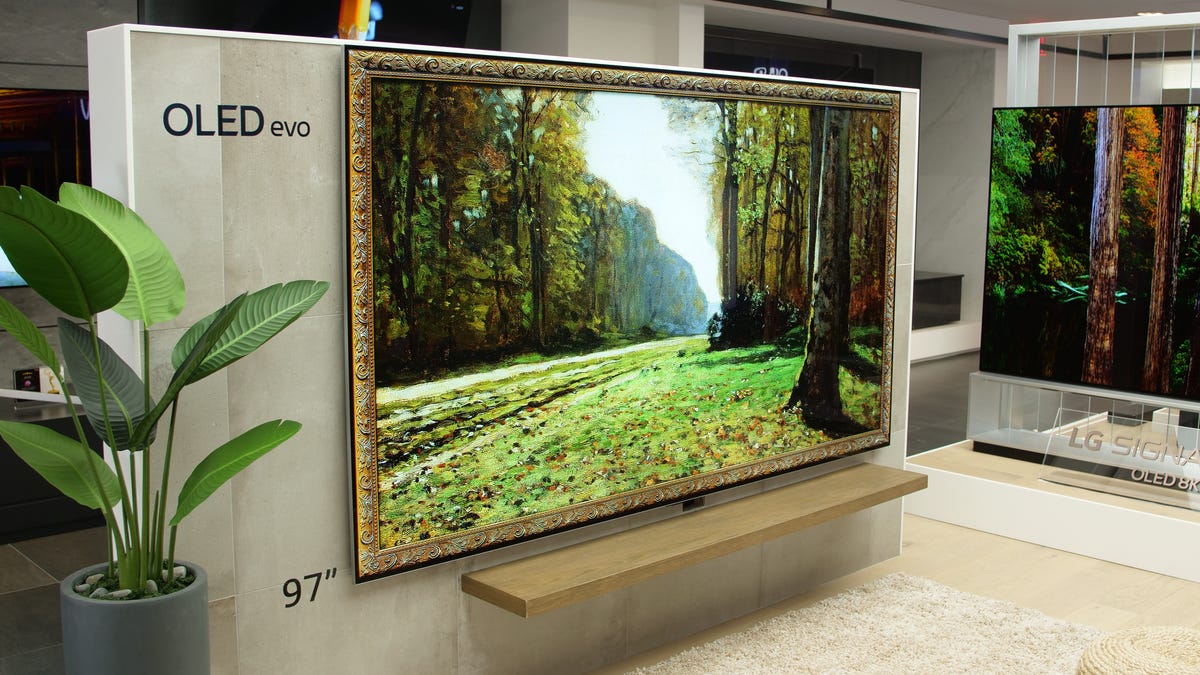Get ready for free NextGen TV broadcasts with these 2022 televisions
Attention, cord-cutters. More 4K antenna-friendly TVs and set-top boxes are on their way.

LG's G2 OLED TV, seen here in a 97-inch size, features an ATSC 3.0 tuner.
The next version of broadcast TV, called NextGen TV or ATSC 3.0, is rolling out across the US, and will reach an estimated 75% of households by mid-2022. Upgrades over current antenna TV potentially include 4K resolution, enhanced sound quality and the web-like ability to interact with broadcasters via your television set. Unlike cable or streaming services, you can watch these broadcast channels for free, over the air with a standard antenna. You can find a list of available ATSC 3.0 areas here, and the number is growing by roughly two markets every month.
The signals are out there, but you also need something to watch them with. Most current TVs won't work with the new broadcasts. The ATSC says that 3 million compatible TVs were sold last year, and the organization estimates that 4.5 million will sell in 2022, but as you can see from the list below, most are high-end models.
LG, Sony and Samsung have produced compatible TVs in 2020 and 2021, and at CES 2022, Hisense was announced as the fourth official manufacturer. The biggest holdout is TCL, whose spokesperson said, "TCL TVs in the US use ATSC 1.0 tuners."
Meanwhile, a couple more companies also sell external tuner boxes, which work out cheaper than a whole new television. Manufacturers are also thinking beyond TVs as well, as there are future plans for including the technology in places such as cars.
Here's a list of 2022 TVs we know about that will feature ATSC 3.0 tuners.
Hisense
The newest manufacturer to add ATSC 3.0 tuners to its TVs, Hisense extends the feature down to the relatively affordable U7 series, which starts at $800.
LG
The 2022 LG G2, seen here on an optional stand, has a thin "gallery" design and a brighter evo panel.
Like last year, LG is restricting ATSC 3.0 support only to its most expensive OLED TVs. LG hasn't announced pricing, but the 2021 version of the G2 series, the G1, starts at $1,700 for a 55-inch size.
- G2: 55-, 65-, 77-, 83- and 97-inch 4K OLED television
- Z2: 77- and 88-inch 8K OLED television
Sony
Sony is the only manufacturer to include ATSC 3.0 support across its entire range so far, and the initiative is now in its second year. As with most TVs on this list, pricing hasn't been announced, but the 43-inch model in the X80K series should cost around $500, if the 2021 version is any indication.
- Z9K: Mini-LED 75- and 85-inch 8K
- A95K: QD-OLED 55- and 65-inch 4K
- A90K: OLED 48, 42-inch 4K
- A80K: OLED 55, 65, 77-inch 4K
- X95K: Mini-LED 65-, 75-, 85-inch 4K
- X90K: Full-array LED 55-, 65-, 75-, 85-inch 4K
- X85K: Direct LED 43-, 50-, 55-, 65-, 75-, 85-inch 4K
- X80K: Direct LED 43-, 50-, 55-, 65-, 75-, 85-inch 4K
Samsung
So far Samsung has only released general information on its 2022 range, not specific models. TechHive reported that the company's Neo QLED line will be coming with ATSC 3.0 tuners, but a Samsung spokesperson told CNET that details were yet to be revealed. "We haven't announced specific number of models just yet, but I can say that our TVs ranging in size from 43-inch to 98-inch will support ATSC 3.0," they said.
Skyworth
China-based Skyworth has a limited presence in the US market so far, but did announce one TV that will have an ATSC 3.0 tuner.
- UD8500: 65- and 75-inch 4K UHD Mini-LED QLED with a bezel-less design
ATSC 3.0 DVRs, starting at $200
The Tablo ATSC 3.0 Quad HDMI DVR.
If you want to watch next-gen TV broadcasts another option is to get an external tuner, which can connect to any TV. Currently they're rare, although a couple OTA DVRs do exist.
In April last year, SiliconDust released the $199 HDHomeRun 4K Flex, which is a DVR with four tuners, two of which are ATSC 3.0. It's a networked device, similar to the Amazon Fire TV Recast, that connects to streaming devices on the network and the internet via the HDHomeRun app.
The only ATSC 3.0 DVR announced for 2022 so far has been the Tablo ATSC 3.0 Quad HDMI. It's coming this spring for $299 and unlike the HDHomeRun it offers four full ATSC 3.0 tuners. The downside is that it's not networkable and so it's restricted to one TV.
At CES, the ATSC organization announced that a low-cost chipset from Mediatek would be available to put into cheaper devices, which could help prices on external tuners come down in the future.
NextGen TV outlook for 2022
There are two main issues with ATSC 3.0 in the US. The first is the lack of coverage in some of the country's biggest TV markets, including San Francisco, Chicago and New York City. The second is a lack of content. While the format promises 4K resolution and features like interactive gambling, these are largely yet to be implemented. Because the service is still maturing and depends on support from broadcasters, most areas still receive only 1080p signals. With budget-friendly devices and more coverage areas on their way, we may find that over the next few years ATSC 3.0 could finally live up to its cord-cutting potential.

